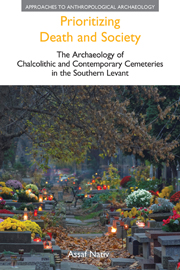 Prioritizing Death and Society
Prioritizing Death and Society from Part III - Contemporary cemeteries
Theoretically, concepts of time and space are complementary, representing distinct but compatible lines of enquiry and observation. In practice, however, analytical choices in favour of one are often realized at the expense of the other. Thus, the temporal analyses offered in the three preceding chapters were made possible only by considering the tombstones and graves as singular isolated units and by entirely relinquishing issues of spatial patterning.
By the same token, a choice in favour of spatial relations implies a weaker hold over the temporal dimension, which, if taken to the extreme, is likely to induce a complete disjuncture with the previous chapters. This is clearly undesirable. Fortunately, the shift in this chapter towards the spatial dimension does not necessarily demand that the temporal dimension be relinquished altogether. Often graves in close physical proximity were observed to be in temporal proximity as well. Spatial clusters can therefore be arranged in relative temporal order, revealing development and allowing some inference into the processes at work.
Two features of cemetery organization will be considered here. One is the occurrence of explicit expressions of association between graves, and the other refers to the distribution of the sexes. In both cases, patterns for several spatial units within each cemetery will be explored; these will subsequently be arranged in relative temporal order, thus offering a glimpse into possible temporal trends.
Explicit association
All contemporary cemeteries in Israel share the same underlying structure.
To save this book to your Kindle, first ensure [email protected] is added to your Approved Personal Document E-mail List under your Personal Document Settings on the Manage Your Content and Devices page of your Amazon account. Then enter the ‘name’ part of your Kindle email address below. Find out more about saving to your Kindle.
Note you can select to save to either the @free.kindle.com or @kindle.com variations. ‘@free.kindle.com’ emails are free but can only be saved to your device when it is connected to wi-fi. ‘@kindle.com’ emails can be delivered even when you are not connected to wi-fi, but note that service fees apply.
Find out more about the Kindle Personal Document Service.
To save content items to your account, please confirm that you agree to abide by our usage policies. If this is the first time you use this feature, you will be asked to authorise Cambridge Core to connect with your account. Find out more about saving content to Dropbox.
To save content items to your account, please confirm that you agree to abide by our usage policies. If this is the first time you use this feature, you will be asked to authorise Cambridge Core to connect with your account. Find out more about saving content to Google Drive.